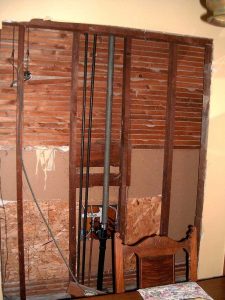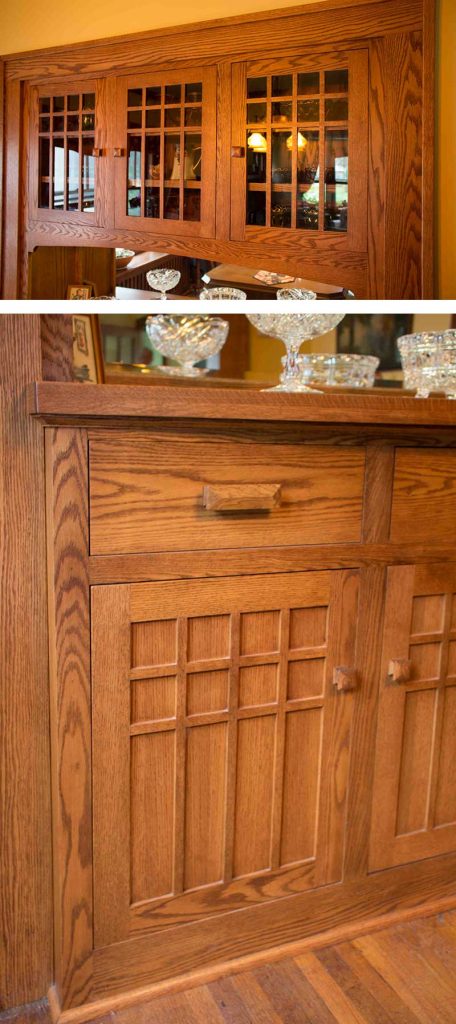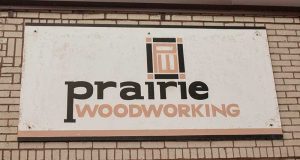Small Home Gazette, Fall 2018
Made-to-Order Buffet
A New Built-in Replaces the Lost Original
Walk into any architectural salvage business, and you will see several, if not dozens, of built-in dining room buffets that were ripped out of bungalows and other early 20th century houses. Since bungalows’ popularity first began to wane in the late 1920s, untold thousands of these classic features have fallen victim to homeowner “improvements.” Some were removed to give the interior a lighter, more modern appearance; others to open the kitchen to the dining room in pursuit of the “open plan” trend.
Like built-ins of any type, however, we believe that dining room buffets are useful as well as beautiful. The lower drawers and shelves comprise generous storage spaces, and the upper cabinets are perfect for holding and displaying decorative and functional items. The central surface top is convenient for moving items on and off the table during meals. And in a room already filled with furniture, which can hinder occupants’ circulation through the home, a built- in buffet stays entirely out of the way. But even with these multiple benefits, they are often sacrificed.
Reversing a Removal
Bungalow Club member John Macy was in such a situation. His parents were only the home’s second occupants when they purchased it in 1954, but the first owner had already removed the built-in buffet.
“She wanted to make room for a free-standing buffet,” says Macy. “So she tore out the original built-in buffet and walled over where it was.”
Macy had long intended to replace the built-in, but other maintenance and repair projects had always taken priority. Three years ago he took the buffet plunge.
Macy always intended to replace the missing buffet with a salvaged piece. Many homeowners have gone this route with varying degrees of success. Built-in buffets were manufactured in several sizes, configurations and styles. Finding one that fits a home can be a challenge. Further challenges include matching the wood finish to the home’s trim and repairing damage that inevitably occurs when a built-in is pried from its original site.

Re-opening the wall revealed the cavity that held the original buffet. Gas lines and sink plumbing limited the depth of the new built-in.
Macy ran into a problem when he began looking at buffets at architectural salvage businesses. “I discovered they wouldn’t fit,” he says. The wall between his kitchen and dining room would only allow for a 12-inch deep cabinet. His wall isn’t as thick as it is in many bungalows, and the home’s gas lines run vertically inside it, further restricting available depth.
Says Macy, “A lot of the buffets I found were 16 or 17 inches deep and up to 22 inches deep.”
Frustrated but not thwarted, Macy explored having a replacement built from scratch. He researched styles and details online. “There are so many on the internet,” says Macy. “Some are very interesting; some I liked and some I didn’t like.” Then the bungalow next door came up for sale. “It’s almost a sister to this one,” explains Macy. He found photos of its dining room buffet on the home’s real estate site. He liked what he saw and harvested the images for future reference.
Reconstructing the Past
The next step was to find a woodworker who was willing to take on the challenge of replicating a vintage furniture piece. That turned out to be easier than expected. Friends recommended Tim Granlund, owner of Prairie Woodworking, located on East Lake Street in Minneapolis. Macy invited Granlund to his bungalow to discuss the project, and the two soon struck an agreement.
Prairie Woodworking was originally founded 30 years ago in Oak Park, Illinois, by Granlund’s brother-in-law. Oak Park, of course, is where Frank Lloyd Wright began his career. The village is now home to 2,400 historic homes and other structures, many quite grand, and many in the Prairie School and Arts & Crafts styles. Back then, says Granlund, the bulk of the business was oak radiator covers. “The owners of those houses didn’t order just two or three covers,” says Granlund. “They’d order ten or fifteen.”
Granlund took over the business and moved it to Minneapolis many years ago. He still makes radiator covers but has expanded to produce a wide range of furniture and cabinetry, including tables, chairs, and, of course, built-ins.
Like many custom projects, completion of Macy’s built-in buffet took longer than originally estimated—a total of five months. That included the construction and installation of the buffet plus the relocation of electrical wiring in the wall and the installation of wiring in the buffet so that the serving area can be lighted.
The total cost of the project was about $5,000—$4,500 for the buffet and $500 for the electrical work.
Was it worth it? “Oh, yes,” says Macy enthusiastically.
Indeed, the end result is thoroughly convincing. Granlund is quite proud of the end result. “We specialize in matching the new wood to the original wood,” he says. Except for the fact that it’s in mint condition, one would swear that the buffet is original to the house.
Do you have a restoration or renovation project that blends well with your home’s original style and would inspire other bungalow owners? Drop us a line at mail@bungalowclub.net.
Resources
Prairie Woodworking
3537 East Lake St., Minneapolis
(612) 327-7249
www.prairie-woodworking.com
Weaver Electrical Construction, Inc.
719 Belmont Lane E., Maplewood, MN
(651) 644-6551















